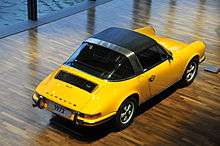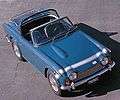Targa top
Targa top, targa for short, is a semi-convertible car body style with a removable roof section and a full width roll bar behind the seats. The term was first used on the 1966 Porsche 911 Targa,[1] and it remains a registered trademark of Porsche AG.[2]

The rear window is normally fixed, but on some targa models, it is removable or foldable, making it a convertible-type vehicle. Any piece of metal or trim which rises up from the side of a car and continues in an uninterrupted line over the roof and down the other side is sometimes called a targa band, targa bar or a wrapover band.
Targa tops are different from T-tops, which have a solid, non-removable bar running between the top of the windscreen and the rear roll-bar, and generally have two separate roof panels above the seats that fit between the window and central t-bar.
Origin
The word targa first came into use from the 1966 Porsche 911 Targa, though it was not the first to use the removable roof panel system. The system first appeared in 1961 on the Triumph TR4, where it was called a surrey top.[3] The 1964 SAAB Catherina prototype and the 1965 Toyota Sports 800 both used similar systems before the 1966 Porsche 911 Targa.
The targa style roof opening became popular in the 1960s and 1970s, when there were fears that the Department of Transportation (DOT) in the United States would ban convertibles, due to concerns over the safety of occupants when a car overturns. As a result, manufacturers adopted Targa tops or T-tops. As Porsche helped to popularise this body style, they took out a trademark for the Targa name and manufacturers sought for alternative names for their removable tops. Porsche got the name "Targa" from the Targa Florio, the famous road race in Sicily where Porsche was very successful. Targa means "plate" in Italian.
Targa and T-top numbers have slowly declined as manufacturers discontinued them in favour of full convertibles with retractable hardtops and folding metal roofs such as the Mercedes-Benz SLK, and by better structural engineering with pop-up roll over bars behind the seats and front roll-over bar incorporated into the front windscreen,
-

Targa top body style (Fiat X1/9 example)
-

Triumph TR250 Surrey Top.
Glass roof
1996 saw the debut of a retractable glass roof in the Porsche 993 Targa, a design continued on the 996 and 997 Targa. The glass roof retracted underneath the rear window revealing a large opening. A shade was there to help prevent the greenhouse effect of the closed roof. This system was a complete redesign, as previous Targa models had a removable roof section and a wide B-pillar functioning as a roll bar. The new glass roof design allowed the 993 Targa to retain nearly the same side-on profile as the other 911 Carrera variants and eliminated the inconvenience of storing the removed top of the old system. The Targa had the body of the Cabriolet with the Targa glass roof replacing the fabric roof. The 911 Targa continued with the all-new 996-model and gained a lifting hatchback glass window.[4] This, in turn, was used on the later 997 model of 911.
Motorized roof
With the introduction and production of the latest 911, the Type 991, Porsche decided to take the latest Targa in a different direction from that of the previous water-cooled Type 996/997 cars. The latest Targa was introduced in 2014 and unlike the Type 993/996/997 Targas, the new car has somewhat returned to its earliest Targa roots by the utilizing of a solid roof panel spanning over the front seats. However unlike the manual lift-out panels of earlier 911s, the Type 991 Targa's roof panel is mechanized for automated lift-away and storage under the rear glass roof, which itself is mechanized to lift up and out of the way as the roof panel is placed into its stowed position. The Type 991 Targa also brings back the styling feature of the 'Targa bar' that was perhaps the most obvious and overt design cue of the air-cooled generation Targas. But unlike the previous Targa hoops, the one used on the Type 991 is in sections, where the horizontal span member is a physically separate piece that itself is mechanized to lift off of its vertical supports in order to allow the solid roof panel and its motorized components to slide rearwards as the panel is being stored within the car.
Rotating roof
Ferrari introduced a hybrid variation of the targa roof and folding metal roof with the 180 degree rotating roof featured on the 2005 Ferrari 575M Maranello Superamerica. The concept was also used in the 2010 Renault Wind.
Examples of traditional Targa tops
Examples of the Targa car body style include:
- AMC Eagle Sundancer (1980–84)
- Bentley Continental SC
- BMW 3 Series Baur Cabriolets E21 TC1 (1978-1982), E30 TC2 (1983 - 1991), E36 TC4 (1992 - 1996)
- Bugatti Veyron Grand Sport (2009-current)
- Chevrolet Corvette coupe (1984–current) 1999-2000 FRC, 2001–2004 Z06, 2006+ Z06, and 2009+ ZR1 excluded
- Ferrari 250P / 250LM / 330P / 330P2 / 330P3 / 330P4 / 412P / 312P
- Ferrari 308 GTS
- Ferrari 328 GTS
- Ferrari 348 TS
- Ferrari 512S/512M
- Ferrari Dino 246 GTS
- Ferrari F355 GTS
- Ferrari F50
- Fiat X1/9
- Ford GTX-1 (1966 12 Hours of Sebring winner)
- Ford GTX-1 Roadster (2005)
- Honda CR-X del Sol
- Honda NSX-T
- Honda S660
- Jaguar XJ-SC 'twin-targa' cabriolet (1984–1988)[5]
- All Koenigsegg models (2004–present)
- Lamborghini Diablo VT Roadster
- Lamborghini Miura Roadster
- Lotus Elise
- Maserati MC12
- Matra 530
- Nissan 100NX
- Pontiac Solstice Coupe (2009)
- Porsche 911 Targa (1966–1992)
- Porsche 914
- Porsche Carrera GT Carrera GT
- Renault Wind
- Saab Catherina prototype (1964)
- Smart Roadster
- Suzuki Samurai
- Suzuki Cappucino (has an optional solid roof which can be converted into a Targa top)
- Tesla Roadster (2008-2011)
- Toyota Sports 800 (1965–1969)
- Toyota Supra
- Triumph TR4 Surrey top (1961)
- Triumph TR4A Surrey top (1965)
- Triumph TR250 Surrey top (1967)
- TVR Tuscan Speed Six
See also
| Look up targa in Wiktionary, the free dictionary. |
References
- ↑ "911 History". Edmunds.com. 2010-02-26. Retrieved 2011-11-20.
- ↑ "Porsche official website". Porsche.com. Retrieved 2011-11-20.
- ↑ Beattie, Ian (1977). The Complete Book of Automobile Body Design. Yeovil, UK: The Haynes Publishing Group. p. 21. ISBN 0854292179.
- ↑ "Evo February 2002". Evo.co.uk. 2002-02-21. Retrieved 2011-11-20.
- ↑ Daily Mail Motor Review 1984 p. 13
